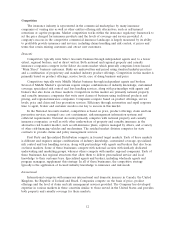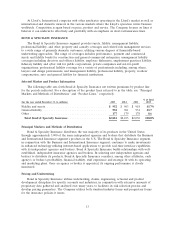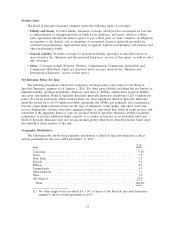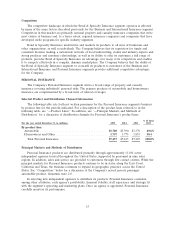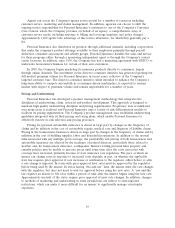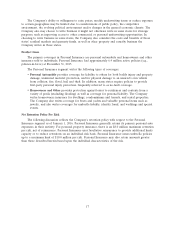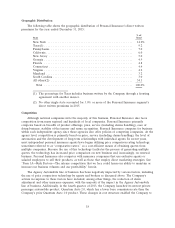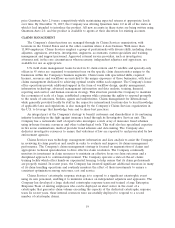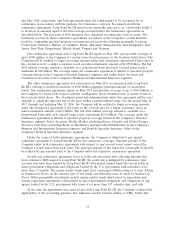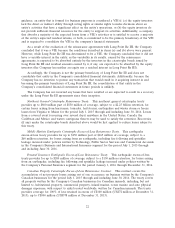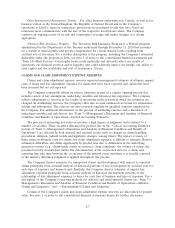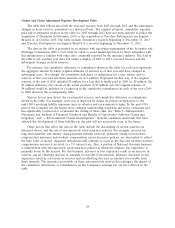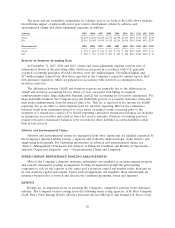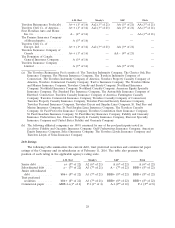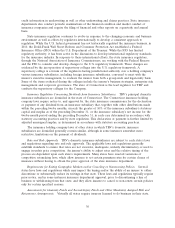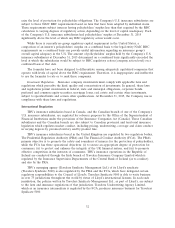Travelers 2015 Annual Report Download - page 22
Download and view the complete annual report
Please find page 22 of the 2015 Travelers annual report below. You can navigate through the pages in the report by either clicking on the pages listed below, or by using the keyword search tool below to find specific information within the annual report.guidance, an entity that is formed for business purposes is considered a VIE if: (a) the equity investors
lack the direct or indirect ability through voting rights or similar rights to make decisions about an
entity’s activities that have a significant effect on the entity’s operations, or (b) the equity investors do
not provide sufficient financial resources for the entity to support its activities. Additionally, a company
that absorbs a majority of the expected losses from a VIE’s activities or is entitled to receive a majority
of the entity’s expected residual returns, or both, is considered to be the primary beneficiary of the VIE
and is required to consolidate the VIE in the company’s financial statements.
As a result of the evaluation of the reinsurance agreements with Long Point Re III, the Company
concluded that it was a VIE because the conditions described in items (a) and (b) above were present.
However, while Long Point Re III was determined to be a VIE, the Company concluded that it did not
have a variable interest in the entity, as the variability in its results, caused by the reinsurance
agreements, is expected to be absorbed entirely by the investors in the catastrophe bonds issued by
Long Point Re III and residual amounts earned by it, if any, are expected to be absorbed by the equity
investors (the Company has neither an equity nor a residual interest in Long Point Re III).
Accordingly, the Company is not the primary beneficiary of Long Point Re III and does not
consolidate that entity in the Company’s consolidated financial statements. Additionally, because the
Company has no intention to pursue any transaction that would result in it acquiring interest in and
becoming the primary beneficiary of Long Point Re III, the consolidation of that entity in the
Company’s consolidated financial statements in future periods is unlikely.
The Company has not incurred any losses that have resulted or are expected to result in a recovery
under the Long Point Re III agreements since their inception.
Northeast General Catastrophe Reinsurance Treaty. This northeast general catastrophe treaty
provides up to $800 million part of $850 million of coverage, subject to a $2.25 billion retention, for
certain losses arising from hurricanes, tornados, hail storms, earthquakes and winter storm or freeze
losses from Virginia to Maine for the period July 1, 2015 through and including June 30, 2016. Losses
from a covered event (occurring over several days) anywhere in the United States, Canada, the
Caribbean and Mexico and waters contiguous thereto may be used to satisfy the retention. Recoveries
(if any) under the catastrophe bonds described above would be first applied to reduce losses subject to
this treaty.
Middle Markets Earthquake Catastrophe Excess-of-Loss Reinsurance Treaty. This earthquake
excess-of-loss treaty provides for up to $150 million part of $165 million of coverage, subject to a
$60 million retention, for losses arising from an earthquake, including fire following and sprinkler
leakage incurred under policies written by Technology, Public Sector Services and Commercial Accounts
in the Company’s Business and International Insurance segment for the period July 1, 2015 through
and including June 30, 2016.
Personal Insurance Earthquake Excess-of-Loss Reinsurance Treaty. This earthquake excess-of-loss
treaty provides for up to $200 million of coverage, subject to a $150 million retention, for losses arising
from an earthquake, including fire following and sprinkler leakage incurred under policies written by
the Company’s Personal Insurance segment for the period January 1, 2016 through December 31, 2016.
Canadian Property Catastrophe Excess-of-Loss Reinsurance Contract. This contract covers the
accumulation of net property losses arising out of one occurrence on business written by the Company’s
Canadian businesses for the period July 1, 2015 through and including June 30, 2016. The treaty covers
all property written by the Company’s Canadian businesses for Canadian insureds, including, but not
limited to, habitational property, commercial property, inland marine, ocean marine and auto physical
damages exposures, with respect to risks located worldwide, written for Canadian insureds. The treaty
provides coverage for 100% of loss retained in excess of C$100 million (US$72 million at December 31,
2015), up to C$800 million (US$578 million at December 31, 2015).
22


